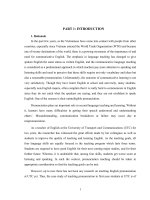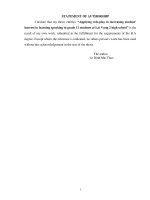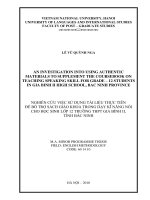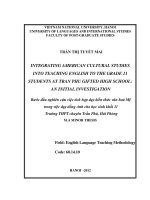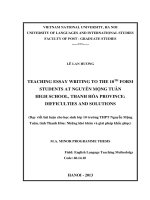Integrating American Cultural Studies Into Teaching English To The Grade 11 Students At Tran Phu Gifted High School An Initial Investigation
Bạn đang xem bản rút gọn của tài liệu. Xem và tải ngay bản đầy đủ của tài liệu tại đây (94.66 KB, 5 trang )
Integrating American Cultural Studies Into
Teaching English To The Grade 11 Students At
Tran Phu Gifted High School: An Initial
Investigation
Trần Thị Tuyết Mai
Trường Đại học Ngoại ngữ
Luận văn Thạc sĩ ngành: English teaching methodology; Mã số: 60 14 10
Người hướng dẫn: M.A. Vũ Thị Thu Thuỷ
Năm bảo vệ: 2012
Abstract. Since the new series of English textbook were put into practice throughout
the country, a great number of researches have been carried out to investigate its
effectiveness and its implementation. Most of the attention was paid to the teaching and
learning of the four macro skills, but there has been little research on how the aspect of
culture in general and American Cultural studies in particular was treated in the actual
classroom under innovation goals. Therefore, this thesis was carried out to explore the
reality of teaching and learning of American cultural studies in the classroom at Tran
Phu Gifted high school. In order to achieve the aim, three instruments were employed:
survey questionnaires, class observation and interview. The data revealed that both the
teachers and the students have positive attitudes towards American Cultural studies
teaching and learning and that not many of the teachers have integrated American
Cultural studies in teaching English, which is so much supported by the students. The
study also pointed out some difficulties that the teachers and the students encounter in
teaching and learning American Cultural studies in the classroom. The paper concludes
with several recommendations by the researchers for more effective integration of
American Cultural studies in actual classroom practice.
Keywords. Tiếng Anh; Phương pháp giảng dạy; Văn hóa Mỹ; Lớp 11; Hải Phòng; Phổ
thông trung học
Content
1. Rationale of the study
It cannot be denied that English has nowadays become a common means of
communication of human being all over the world. Perceiving that trend of the global
integration, Vietnam has been more and more active to train active and dynamic Vietnamese,
who can use English fluently for communicative purposes. That is the reason why in 2002, the
Ministry of Education and Training (MOET) has set out new aims for English language teaching
for secondary education as well as introduced new series of English textbooks from grade 6 to
grade 12.
The new English textbooks for high school students are divided into two sets: the
advanced and the standard. Each unit in the new English textbooks consists of five parts:
Reading, Speaking, Listening, Writing and Language Focus, among which the Language Focus
sections are to consolidate students’ pronunciation and grammar. They are claimed to adopt the
latest teaching and learning approaches: communicative approach and learner-centered approach
and aim at developing both language skills and language knowledge for students.
Since their nation-wide implementation in the school year 2006-2007, a great number of
researchers have been carried out to evaluate these new textbooks as well as to find out how
these textbooks are actually implemented or the difficulties that teachers and students at high
schools have to face when teaching and learning with the new textbooks. Most of these studies
have dealt with the teaching and learning of the four language skills which are believed to be
new for both teachers and students. However, there is still one more indispensable aspect which
tends to be depreciated. It is culture that turns out to be the fifth skill in language learning and
tacked on to the teaching of speaking, listening, reading, and writing. It always stays in the
background to decide the good language learners when paid enough attention to. It supports
learners to achieve their communicative competence. Nevertheless, the number of research on
the teaching and learning of culture in general and America studies in particular in the classroom
is obviously limited. It is necessary to carry out more research on how teachers and students
teach and learn culture in the actual classroom.
Besides, national examinations (national examinations for GCSE, university entrance
examinations) have currently included some questions related to American cultural studies issues
(for example: how to address certain situations, etc.)
On the other hand, there are various cultures that English language is getting connected
with. Among those, the United States has a leading economic, political and cultural force in the
world. Moreover, the United States is also the ideal destination for overseas students, which has
resulted from its top-ranking education system. Thus, learning about the culture of the United
States appears to be a wise choice.
Moreover, after two years of teaching English with the new English textbooks at Tran
Phu Gifted High School, the researcher observed that the teachers and learners there faced a
number of difficulties in teaching and learning American cultural studies in the classroom.
According to Bada (2000: 101), “the need for cultural literacy in ELT arises mainly from
the fact that most language learners, not exposed to cultural elements of the society in question,
seem to encounter significant hardship in communicating meaning to native speakers.” In
addition, nowadays the L2 culture is presented as an interdisciplinary core in many L2 curricula
designs and textbooks (Sysoyev & Donelson, 2002).
Stimulated by the above reasons, the researcher has decided to conduct this study. It is
hoped that this study will discover the reality of teaching and learning American cultural studies
at Tran Phu Gifted high school in order to contribute some immediate solutions.
2. Aims of the study
The aim of this study is to examine the current teaching and learning of American cultural
studies in the high school classroom at Tran Phu Gifted High School.
In order to achieve the aim, the study seeks to find out:
(1) The teachers’ and students’ perceptions on the importance of American cultural studies
teaching and learning
(2) How the teachers and the students deal with American cultural studies in the classroom
(3) The teachers’ perceived difficulties in teaching and learning American cultural studies in
the classroom
3. Research questions:
To achieve the aim and objectives of the study, the following research questions were proposed:
1. How do the teachers and the students at Tran Phu Gifted High School perceive the
importance of American cultural studies teaching and learning?
2. How do the teachers teach and the students learn / expect to learn American cultural
studies in high school classroom?
3. What method and techniques do the teachers and the students use / expect to use?
4. What are the difficulties in teaching and learning American cultural studies as perceived
by the teachers?
4. Scope of the study.
This study is limited to the teaching and learning reality with regard to teaching and
learning American cultural studies in the classroom.
This study is a detailed survey at Tran Phu Gifted High School in Hai Phong. Therefore,
the findings of the study are not intended to be generalized to other school contexts. Indeed the
findings may not apply beyond the actual participants in this particular study.
5. Significance of the study
This study helps to identify the problems and suggests ways of improving them;
therefore, it is hoped that this study will be beneficial in many ways. First, participants in the
study (the teachers and the learners at Tran Phu Gifted High School) will benefit immediately
from the experience of reflection. Secondly, the findings of the study will contribute information
to textbook writers and educators to determine curricula and program direction.
6. Method of the study
The study was designed to use both quantitative and qualitative methods. Then, various
instruments were used to collect the data for the study from different sources:
- survey questionnaires to investigate the teachers’ and students’ attitudes towards American
cultural studies, their teaching and learning habits and their difficulties in teaching and learning
American cultural studies in the classroom
- class observations to get information about both the teachers’ methods of teaching and
students’ ways of learning American cultural studies in the classroom.
- interviews with the teachers to get in-depth information about the teachers’ and the grade 11
students’ suggestions to improve the teaching and learning of American cultural studies in the
classroom.
7. Design of the study
The study is divided into three parts: Introduction, Development and Conclusion.
The Introduction presents an overview of the study including the rationale, aims, scope,
significance, methodology and design of the study.
The major part of the study, the Development, is divided into three chapters. Chapter one
provides theoretical background for the study. Chapter two presents the methodology of the
study and the last chapter is devoted to analyzing and discussing the findings of the study.
The Conclusion part provides a brief summary of the findings in correspondence with
the four proposed research questions as well as offering some recommendations for better
American cultural studies teaching and learning. The limitations of and suggestions for further
study are also discussed in this chapter.
Besides, the survey questionnaires for the teachers and students and the suggested lesson
plan are included in the Appendices.
References
Ardila-Rey, A. (2008). Language, culture, policy, and standards in teacher preparation: Lessons
from research and model practices addressing the needs of CLD children and their
teachers. In M. E. Brisk (Ed.), Language, culture, and community in teacher education
(pp. 331-351). New York, NY: Lawrence Erlbaum.
Agasild, A. (1998). Teaching Culture in Language Classes. Graduation paper. Tallinn.
Allen, W. P. (1973). A Cultural Checklist: A Technique for Selecting Reading Materials for
Foreign Students. Portland, Oreg.: English Language Services.
Blatchford, C. H. (1986). Newspapers: Vehicles for teaching ESOL with a cultural focus Brooks,
N. (1986). Culture in the classroom. In J. M. Valdes (Ed.), Culture bound (pp. 130-136).
New York, NY: Cambridge University Press.
Bonvillain, N. (2000). Language, culture, and communication: The meanings of messages.
Upper Saddle River, NJ: Prentice Hall.
M. E. Brisk (Ed.), Language, culture, and community in teacher education. New York, NY:
Lawrence Erlbaum.
Brooks, N. (1959). Language and language learning. New York, NY: Harcourt Brace & World.
Brooks, N. (1986). Culture in the classroom. New York, NY: Cambridge University Press.
Brown, S., & Eisterhold, J. (2004). Topics in language and culture for teachers. Ann Arbor, MI:
University of Michigan Press.
Brown, H. D. (2007). Principles of language learning and teaching. New York, NY: Pearson
Education.
Brown, H. D. (2007a). Teaching by principles: An interactive approach to language pedagogy.
New York, NY: Pearson Education.
Byram, M., & Grundy, P. (2003). Context and culture in language teaching and learning.
Tonawanda, NY: Multilingual Matters.
Byram, M., Morgan, C., & Colleagues. (1994). Teaching-and-learning: Language-and-culture.
Bristol, PA: Multilingual Matters.
Byram, M. and Planet, M. T. (2000). Social identity and European dimension: intercultural
competence through foreign language learning. Graz: Council of Europe Publishing.
Byram, M. and Morgan, C. (1994). Teaching-and-learning language-and-culture. Clevedon:
Multilingual Matters.
Byram, M. (1989). Cultural studies in foreign language education. Clevedon, England:
Multilingual Matters.
Byram, M., & Esarte-Sarries, V. (1991). Investigating cultural studies in foreign language
teaching: A book for teachers. Clevedon, England: Multilingual Matters.
Fox, L. (1999). Reflections on culture. Dialog on Language Instruction
Gaston, J. (1984). Cultural awareness teaching techniques. Brattleboro, VT: Pro Lingua
Associates.
Gleeson, P., & Wakefield, N. (1968). Language and culture. Columbus, OH: Charles E. Merrill.
Goodenough, W. H. (1957). Cultural anthropology and linguistics. In P. L. Garvin (Ed.), Report
of the Seventh Round Table Meeting on Linguistics and Language Study (pp. 167-173).
Washington, DC: Georgetown University Press.
Hanna, B. E., & de Nooy, J. (2009). Learning language and culture via public internet
discussion forums. New York, NY: Palgrave Macmillan.
E. Hinkel (Ed.), Culture in second language teaching and learning. New York, NY: Cambridge
University Press.
Kramsch, C. (1991). Culture in language learning: A view from the States.
B. Ginsberg, and C. Kramsch (eds), Foreign language research in cross-cultural perspective.
Amsterdam: John Benjamins.
Kramsch, C. (1993). Context and Culture in Language Teaching. Oxford: Oxford University
Press.
Kramsch, C. (1998). Language and Culture. Oxford: Oxford University Press
Krasner, I. (1999). The role of culture in language teaching. Dialog on Language Instruction, 13
(1&2).
Kuang, J. F. (2007). Developing students‟ cultural awareness through foreign language teaching.
Sino-US English Teaching.
Mead, M. (1961). Culture in foreign language teaching: The anthropologist point of view. In
Report on a conference on the meaning and role of culture in foreign language teaching.
Georgetown University.
Peterson, E. & Coltrane, B. 2003. Culture in Second Language Teaching. Digest [Online], 5 pp.
[ 23.04.2004.
Valdes, J. M. (ed.) 1986. Culture Bound. Bridging the cultural gap in language teaching.
Cambridge: Cambridge University Press.
Valette, R. M. 1986. The culture test. In J. M. Valdes (ed.), Culture Bound. Bridging the cultural
gap in language teaching. (Cambridge: Cambridge University Press).
Scollon, R. (1999). Cultural codes for calls: The use of commercial television in teaching culture
in the classroom. In E. Hinkel (Ed.), Culture in second language teaching and learning
(pp. 181-195). New York, NY: Cambridge University Press.
Seliger, H. (1988). Psycholinguistic issues in second language acquisition. In L. Beebe (Ed.),
Issues in second language acquisition: Multiple perspectives. New York, NY: Newbury
House.
Sercu, L. 1998. In-service teacher training and the acquisition of intercultural competence. In M.
Byram and M. Fleming (eds.), Language Learning in Intercultural Perspective.
Approaches through drama and ethnography. (Cambridge: Cambridge University Press)
Stern, H. H. 1992. Issues and Options in Language Teaching. Oxford: Oxford University Press.
